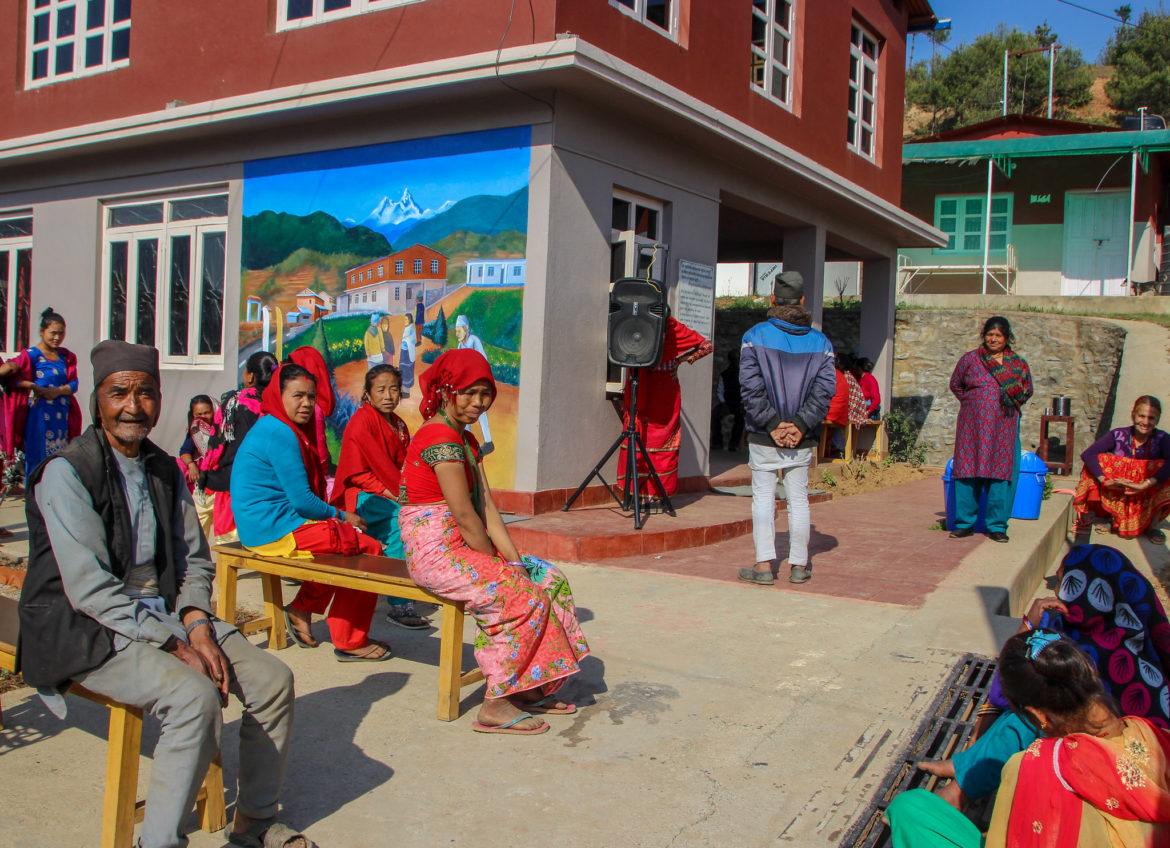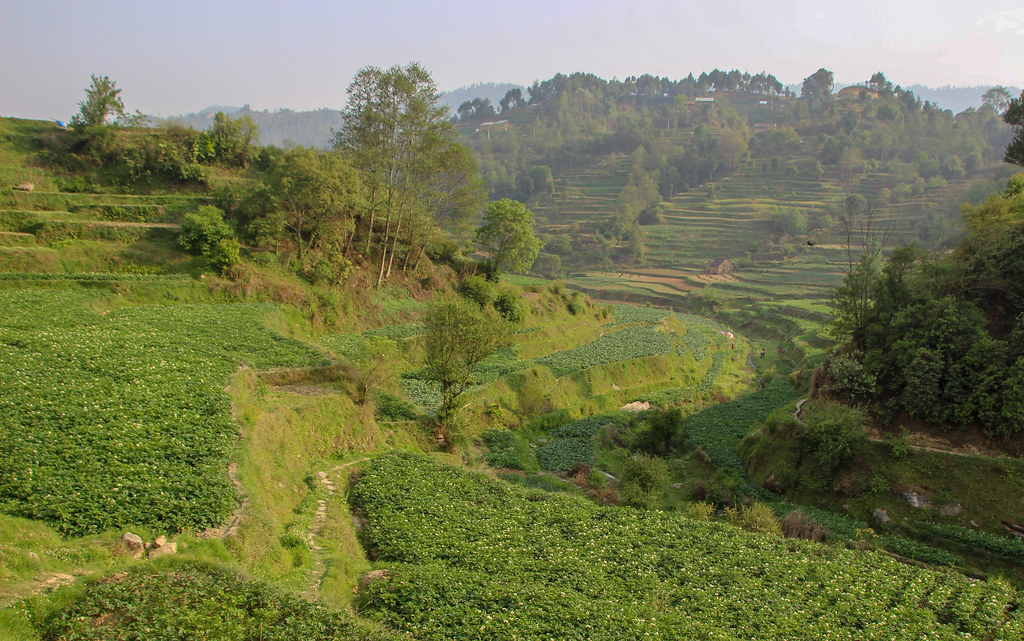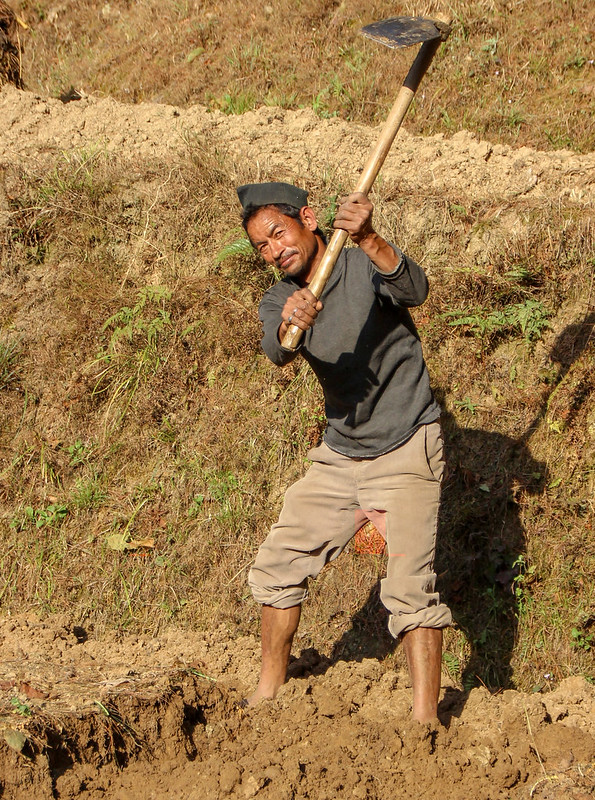“Namaste, from the top of the world!” The radio speakers blasted at 8 am, outside the Acupuncture Relief Project (ARP) Clinic in the farming village of Bajra Barahi, Nepal. 20 patients are calmly waiting outside. As an American Acupuncture Physician, I delved into this unique opportunity as Nepal’s ARP Acupuncture Volunteer for 9 weeks in the spring of 2018. Finally, after giving 585 acupuncture treatments, my mind and heart expanded to a whole new world, that I warmly embrace with awe.
Agricultural Setting for Acupuncture Relief Project
Setting for Nepal’s ARP Acupuncture Volunteer
The ARP site setting in a traditional farming village is important to imagine, because the patients are an organic extension of the land. The lush, pastoral landscapes are part of a basin, with terraced agriculture along the mountainsides. Also, in rural Nepal there are few cars, with mostly just motorcycles ridden by the younger people.
Most of the patients get to the clinic by walking, bus or tuk tuk. It’s not unusual for a patient to walk 2-3 hours for their acupuncture appointment with an injury. Therefore, the clinic gives priority to treat in the morning all patients that live far away. Then they do not need to walk home in the dark. However, we sometimes have to question if the patient should get less acupuncture than needed, because it would be better for them to stay home and rest.
Related: Life Changing Nepal Walking Tour in Agricultural Communities
Medical Interpreters for Nepal’s ARP Acupuncture Volunteer
At ARP, the language barrier is overcome with the 4 young, vibrant Nepalese Medical Interpreters. There is a model from which ARP follows when doing an intake. Firstly, the Acupuncturist sits directly across from patient, with the interpreter off to the side. It’s important to simplify questions to gain clear perspective and prevent misunderstandings or vague replies.
Learning about the patients with a language barrier cultivated a multi-dimensional lesson. I learned to use nonverbal communication skills and compassion, while observing facial expressions and body language. For me, it was an opportunity to tap into my intuition for information. This is a useful skill to take home, as when we lock ourselves into the verbal, analytical mind, we lose profound insights about the patient.
Most people in rural Nepal follow Hindu traditions.
The majority of the people in this district follow Hindu cultural traditions, as it is the predominant religion in Nepal. Almost everyone greets you with palms pressed together, saying ‘Namaste.” Namaste is a Sanskrit word used mainly in India and Nepal. It means “the divine and self is same in you and me.”
It’s a delight that this one word with a smile, can transcend any language barrier into a heart connection. I experienced it over and over again with my patients and other Nepalese people. It became a heart meditation for me, to instill the habit of connecting with others in a divine way.
Since Nepal remained an independent monarchy in the 18th and 19th centuries, it retained most of its traditional clothing and customs. Men wear a long tunic or vest over baggy pants, with a wool topi hat, placed on top of the head. Women don’t reveal their shoulders or legs and wear long skirts or baggy, harem-like pants with a long kurta shirt. The colors swirling around are vibrant from their traditional fabric designs. Many of the women and men come in the clinic, with tika blessing of red ink on the forehead between their eyes. Most women wear bangles wrapped so tight around their wrists that they sleep in them.
Creative Challenges as Nepal’s ARP Acupuncture Volunteer
Navigating the bangles while doing acupuncture on the wrists is a bit of a creative challenge. One of my patients graciously gifted me sparkling, cobalt blue bangles that I love. Also, most women wind themselves up with a patuka. This clothing wraps 3-4 times around the waist to support the back. Therefore, preparing female patients for a back treatment can take more preparation. Usually, they need a minute or 2 to unwind their patuka.
Nepali Feet Customs
Traditionally, Nepali’s are very conservative about their feet, as they consider feet the dirtiest part of the body. Many literally live out this concept with dirty feet. As farmers, their lifestyles involve working a lot in the fields, often in just flip-flops. Plus, the rural Nepali’s don’t regularly wash their feet. They share outdoor community faucets for cleaning and laundry. So, water is not easily accessible, like we are used to in developed nations.
One time a patient sitting on a bed accidentally touched my leg with her foot. Instantly, her face alarmingly lit up, then came a knee-jerk reaction: she touched her own hand and pointed towards my feet, then tapped her head, while whispering something. This lead me to find out, that if Nepal’s accidentally touch someone else with their feet, they immediately apologize with this ritual, while repeating Vishnu’s name, in essence saying “Your feet are higher than my head.” Likewise, they are reserved about having their own feet touched by others.
Thus, before beginning a Nepalese treatment, I ask the patient first, if it’s ok for me to needle their feet. With acupuncture, needling the feet and hands are important, as this is the location of most nerve endings in the body. Later, I noticed that some of my patients began to return for treatments with cleaner feet.
My Final Lesson with ARP
I will conclude with an interesting discovery made my last week in the clinic about the Nepali people and their culture. After treating many patients, it came to my attention that none of my patients had ever said please or thank-you. They would come in for my services and tell me to treat their problem, for example, put needles in my knees or back; or I want medicine (meaning herbs). They expressed appreciation with gifts and nice comments about their treatments. However, there was a sort of bluntness or what I perceived as entitlement, that did not settle with me well among many (not all) of my patients.
Finally, during my last week in the clinic, I asked Gunaraj, one of the Medical Interpreters, “Are there any words for please or thank you in Nepali language?” He briefly answered, “No, because everyone just helps each other out.” This tied in with what I heard earlier, about the Nepalese custom to readily share food and resources. My mind lit up, realizing it’s a cultural given here. Communal support is the way, with no extra politeness needed. Respect and gratitude go without saying. Getting this, I gladly embraced the aha moment! Then, I seriously began to question American schmoozing shenanigans, like “pretty please with sugar on top.”
Read more about Acupuncture Relief Project!
American Acupuncturist Meets Nepali Patients, Part 2: Being Primary Care Practitioners
Volunteer Opportunities for Healthcare Practitioners with Acupuncture Relief Project in Nepal
American Acupuncturist Meets Nepali Patients, Part 3: Common Health Problems in Nepal








